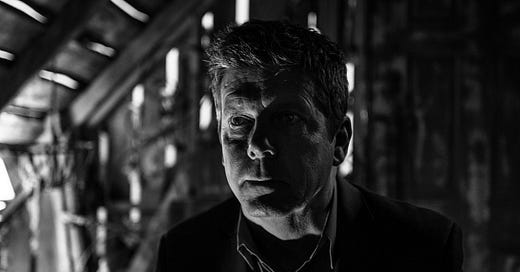Peter Deming (Part 2)
The versatile cinematographer on Scream, The Cabin in the Woods, and the art of getting the audience to see only what you want them to see.
“Horror doesn’t always have to be dark. There are other ways to scare you, certainly through character.”
Interview by Kurt Sayenga
THE VISUAL CONVENTIONS OF HORROR
KS: Do horror movies have specific visual conventions? To what extent do you cleave to those?
PD: Do they have a set of visual conventions? Yeah, I suppose they do. The cliché ones are “What’s behind the door?” “What’s around the corner?” And I think that you can still get away with those as long as you don’t telegraph them. I like using composition in the same way. There is a very scary and funny shot in Cabin in the Woods where a character comes out of the cabin at night and he’s in the front yard and he’s trying to find his friend and he’s sort of looking around and calling his name and suddenly [the friend] just bursts in from the side of the frame. When you analyze it, it’s sort of like, “Why didn’t he see him coming?” But because of this frame you’re watching, at the moment that it happens, you don’t really think about that. You just react to the scare. Drew [Goddard], the director, kept it moving right after that. The friend bursts in and then they run into the house and you’re onto something else before you can say, “Wait a minute..!” It’s stuff like that that I enjoy playing with because it still works with the genre. And it’s a different way to do the same thing, even though in reality, when you analyze it, it’s not exactly kosher.
KS: That speaks to the dream-like nature of movies in general, and horror films as being a way of capturing our nightmares. When you’re working on a film, do you think that way?
PD: Yeah, I think you’re either taking reality and trying to heighten it, or making it dreamlike but having enough reality to relate to and to grab onto. To me the best accolade for a horror film is having the audience say to themselves, “It’s only a movie, it’s only a movie...” They have to remind themselves because it’s working, basically.

FILMING THE UNSEEN
KS: What films drew you towards cinematography?
PD: Going way back, I was a big Orson Welles fan. Obviously Citizen Kane, but when I saw Touch of Evil, that really taught me about what cinematography could do to support a narrative and be very stylized at the same time. That’s still a film that I watch fairly regularly because to me it’s very inspiring.
KS: How would you characterize your approach to a film project, whether it’s a genre project or not? Do you adapt to the project or do you bring in a very defined style, like Vittorio Storaro?
PD: I try not to have a style. I think you have to sort of cover all the bases and be able to do lots of styles and genres. Otherwise, that’s all you’ll get offered. You want to stretch yourself and do a lot of different works. You have to be flexible.
KS: When you’re making horror films, is there a difference in how expressive you can be versus shooting a more mainstream feature?
PD: In the horror genre or mystery or scary or whatever genre, there is a lot that’s done without dialogue, and I think that’s a great thing for a cinematographer, because you’re telling the story through pictures. Horror films tend to be more subjective in their viewpoint as opposed to objective, and that’s also a lot of fun to play with. You can be the viewer and take them through the story and really choose what they see and don’t see.
KS: What are some examples of that in your work?
PD: Well, in my work probably the most obvious choice would be the Scream movies, because you’re always following this character or that character into
Keep reading with a 7-day free trial
Subscribe to The Horror Xpress to keep reading this post and get 7 days of free access to the full post archives.





